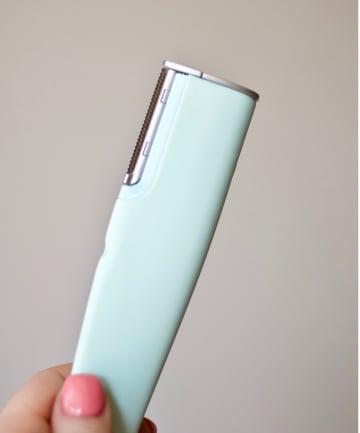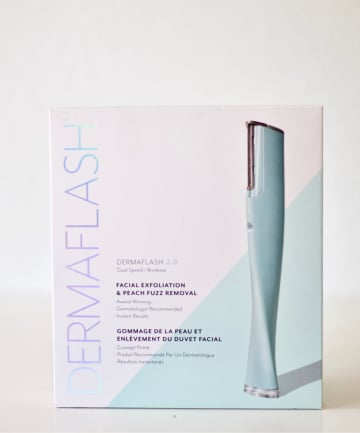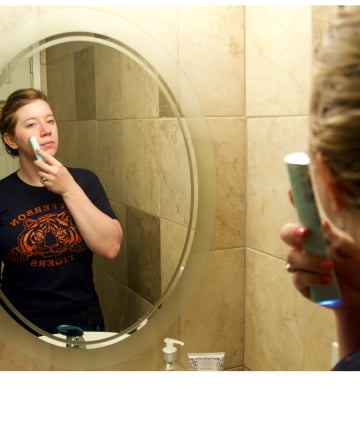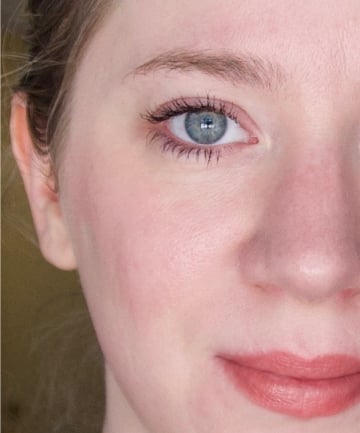For those out of the beauty loop, dermaplaning is a relatively new skin care trend that involves shaving all the fuzzy peach hair off your face. It's a great regimen for those who have a little extra hair they want to nix, but it's so much more than that. Dermaplaning is primarily a form of exfoliation that leaves your skin ultra-soft to the touch, thereby allowing makeup to glide on more easily and, potentially, allowing your skin to soak up more of whatever actives or moisturizers are in your products.
It's a service that's historically offered by professionals, but a few brands have also released dermaplaning tools that you can use in front of your very own bathroom mirror. Curious about how effective this technique actually is — and not really keen on making an appointment — I decided to give the Dermaflash 2.0 a whirl. But first, I consulted some estheticians to see what I was getting myself into. I'll share what I learned ahead and then relay my personal at-home experience at the end. Let's do this!
Image via Wendy Rose Gould
Cover image via Miguel Maldonado, Unsplash
It's a service that's historically offered by professionals, but a few brands have also released dermaplaning tools that you can use in front of your very own bathroom mirror. Curious about how effective this technique actually is — and not really keen on making an appointment — I decided to give the Dermaflash 2.0 a whirl. But first, I consulted some estheticians to see what I was getting myself into. I'll share what I learned ahead and then relay my personal at-home experience at the end. Let's do this!
Image via Wendy Rose Gould
Cover image via Miguel Maldonado, Unsplash
As mentioned, dermaplaning is a non-invasive form of exfoliation that requires zero downtime after you're finished. It not only removes the peach fuzz (known as vellus hair) but also the corneal layer — aka the thickened, rough layer of skin. A sterile, surgical blade is placed at a 45-degree angle and light shaving strokes are made. Note that the blade is intended to remove only the vellus hair and not terminal hair, such as eyebrows or beards.
If you want to maintain that velvety smooth skin, then you'll want to repeat the process about once a month. However, if you try it and feel like it's not worth the upkeep, you can simply allow the hair to grow back. The good news is that as your hair grows back, the bluntness of the hairs will soften back to normal.
"There is a misconception that shaved hair versus waxed grows thicker, but that is just a feeling of the blunt hairs that were cut short," notes Biba de Sousa, an esthetician based in Los Angeles. "Waxed hair grows pointy because it is pulled out of the follicle and it feels softer, but there is no way that shaving will make hair grow faster or thicker."
Image via Miguel Maldonado, Unsplash
If you want to maintain that velvety smooth skin, then you'll want to repeat the process about once a month. However, if you try it and feel like it's not worth the upkeep, you can simply allow the hair to grow back. The good news is that as your hair grows back, the bluntness of the hairs will soften back to normal.
"There is a misconception that shaved hair versus waxed grows thicker, but that is just a feeling of the blunt hairs that were cut short," notes Biba de Sousa, an esthetician based in Los Angeles. "Waxed hair grows pointy because it is pulled out of the follicle and it feels softer, but there is no way that shaving will make hair grow faster or thicker."
Image via Miguel Maldonado, Unsplash
As mentioned, the shaved skin makes for a more efficient canvas when it comes to makeup application and topical products are absorbed more easily afterward. The latter reason is why many estheticians suggest pairing it with a chemical exfoliating treatment, sheet mask and/or a moisturizer. The skin care benefits don't stop there, though.
"Dermaplaning alleviates dull, sluggish, lackluster skin as well as soft fine facial hair that traps dirt and oil," notes Rhea Souhleris Grous, an esthetician at Union Square Laser Dermatology. "It also improves clarity of the skin, and also diminishes the look of fine lines [since] dry, lifeless skin is removed and healthier cells are exposed to be better hydrated."
Note: If you have very sensitive skin or deal with skin issues such as psoriasis or eczema, it's best to skip the dermaplaning. Also, individuals with thick, dark hair and those prone to folliculitis (which is often the former) should avoid dermaplaning as well.
"Dermaplaning alleviates dull, sluggish, lackluster skin as well as soft fine facial hair that traps dirt and oil," notes Rhea Souhleris Grous, an esthetician at Union Square Laser Dermatology. "It also improves clarity of the skin, and also diminishes the look of fine lines [since] dry, lifeless skin is removed and healthier cells are exposed to be better hydrated."
Note: If you have very sensitive skin or deal with skin issues such as psoriasis or eczema, it's best to skip the dermaplaning. Also, individuals with thick, dark hair and those prone to folliculitis (which is often the former) should avoid dermaplaning as well.
There are a few at-home dermaplaning options to choose from, ranging from Sephora's Level Setter Razors, $8, to Tweezerman's Bright Complexion Facial Dermaplaner, $100, to the Dermaflash 2.0 Luxe Facial Exfoliating Device, $189. I opted for the Dermaflash, which is a pretty high-tech option that was developed specifically for the sensitive, delicate skin of a woman's face (you can thank estrogen levels for that). It's basically nick-proof and its primary goal is to remove that corneal layer of skin we talked about earlier. Consider the peach fuzz removal a bonus.
Setting up the device was simple enough. You just insert the Dermaflash into the charger until it's ready to go. Regarding preparation, both estheticians said it's important to start with a clean, bare face as well as clean hands. Skin should be completely clean, so wash twice if you need to, and completely dry before beginning.
Grous also says to "avoid going over same areas repeatedly as this might cause irritation, and to use a toner with antiseptic properties [since] it's important to maintain a clean complexion." Also — never use the same blade twice.
Image via Wendy Rose Gould
Setting up the device was simple enough. You just insert the Dermaflash into the charger until it's ready to go. Regarding preparation, both estheticians said it's important to start with a clean, bare face as well as clean hands. Skin should be completely clean, so wash twice if you need to, and completely dry before beginning.
Grous also says to "avoid going over same areas repeatedly as this might cause irritation, and to use a toner with antiseptic properties [since] it's important to maintain a clean complexion." Also — never use the same blade twice.
Image via Wendy Rose Gould
Honestly, I was pretty hesitant to do this. While I'm a sucker for trying new treatments — even those that require major upkeep — I wasn't sure if the subtle results would be worth my time and the potential for stubble is hella annoying. I continued to feel nervous even mid-stroke on that first pass over my cheek, but as I watched the removed fuzz accumulate, I finally started getting into it.
The whole process only took about 10 to 15 minutes and was completely painless. I'd describe the sensation as dry exfoliation or "dry shaving" (basically what it is), which I thought might irritate my skin. However, even immediately after finishing, my skin looked glowy and not red or inflamed. I followed up with a thick moisturizer and literally had to command myself to stop touching my face for the rest of the day. Even sitting here typing this — days later — it feels incredibly soft to the touch.
Some people who dermaplane note that their jaws look more defined but I have to admit, I didn't notice that. Maybe it's because I didn't have a ton of peach fuzz to begin with, or maybe my jawline is just hopelessly undefined. My primary takeaway was super soft skin and makeup that definitely glides on more easily. I have yet to deal with any annoying grow-back (the Dermaflash isn't as blunt of a removal as some, so that helps) and plan to repeat the process in a month because...why not? It's 10 minutes of my time, the results are soft and bright skin, and the expensive products I slather on my face are absorbed more efficiently. Sounds like a total win to me!
Image via Wendy Rose Gould
The whole process only took about 10 to 15 minutes and was completely painless. I'd describe the sensation as dry exfoliation or "dry shaving" (basically what it is), which I thought might irritate my skin. However, even immediately after finishing, my skin looked glowy and not red or inflamed. I followed up with a thick moisturizer and literally had to command myself to stop touching my face for the rest of the day. Even sitting here typing this — days later — it feels incredibly soft to the touch.
Some people who dermaplane note that their jaws look more defined but I have to admit, I didn't notice that. Maybe it's because I didn't have a ton of peach fuzz to begin with, or maybe my jawline is just hopelessly undefined. My primary takeaway was super soft skin and makeup that definitely glides on more easily. I have yet to deal with any annoying grow-back (the Dermaflash isn't as blunt of a removal as some, so that helps) and plan to repeat the process in a month because...why not? It's 10 minutes of my time, the results are soft and bright skin, and the expensive products I slather on my face are absorbed more efficiently. Sounds like a total win to me!
Image via Wendy Rose Gould








